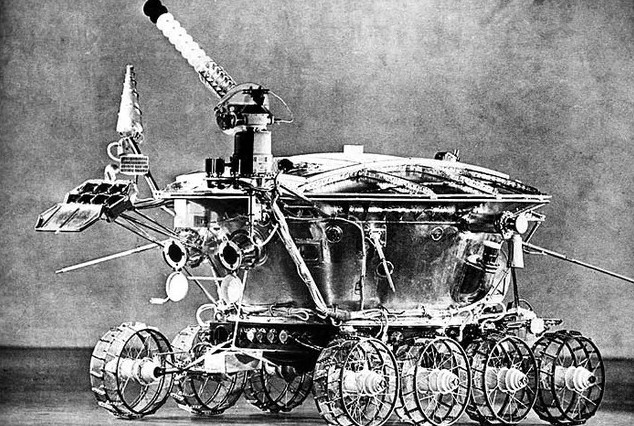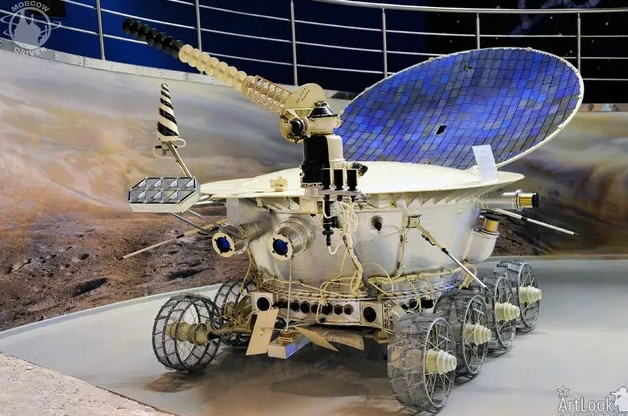November 10, 1970 - Soviet Lunokhod-1 self-propelled vehicle is launched into space
On November 10, 1970, the Soviet Luna 17 spacecraft brought Lunokhod-1 self-propelled vehicle to the surface of the Moon. 11 months later, under the control of a group of technicians in Moscow, Lunokhod-1 discovered 12km on the surface of the Moon, sending much data to Earth. This is considered to be one of the biggest successes of the Soviet Moon exploration program. However, Lunokhod-1 suddenly disappeared and no information was sent.
November 10, 1970 - Launching a vehicle to explore the moon Lunokhod-1
NASA tried to locate Lunokhod-1. It is not until early 2010 that the exact coordinates are determined. Surprisingly, this pedestrian vehicle caught NASA's signal and sent a feedback signal to the observatory in a clear and sharp way. After Lunokhod-1 was brought to the Moon, Lunokhod-2 also followed in 1973. This second probe still regularly sends data to research on Earth. Compared to juniors, Lunokhod-1 sends stronger signals.

Lunokhod-1 self-propelled vehicle.
'The best signal we received from Lunokhod-2 for 7 years was 750 photons but we received 2,000 photons from Lunokhod-1 after contacting the probe again. It seems Lunokhod-1 has a lot to say after 40 years of silence , "said Tom Murphy, the research leader. Lunokhod 1's case will be researched by NASA to increase the effectiveness of the probe. Typically, active detectors weaken after about 10 years are put on the Moon.
During the 'cold war' period , space missions were prepared in top secret mode. So is the Lunokhod scheme . No one expected that, behind the high fence surrounding the test site, located on the Crimean peninsula, the self-propelled car was practicing to overcome obstacles. No one knows about the tests on the Kamchatka Peninsula, where the landscape is very similar to the surface of the Moon. The starting date also kept secret. The official announcement is only about the launch of the 'Luna-17' space station .

And only after the 'Luna-17' station safely landed in the Rainy Sea area on the Moon and the 840 kg self-propelled vehicle separated from the station, was the Lunokhod world known. Here is Vikenty Samal's account, a technician who controlled Lunokhod-1: 'As planned, self-propelled vehicles must measure the terrain and study geological morphology on the Moon. Thanks to this device, it analyzed the composition of soil samples and radioactivity on the surface of the Moon, studied cosmic rays and performed a Moon-based positioning experiment with laser devices'.
The group of self-propelled drivers consists of 5 people. They watched the Moon landscape on the TV screen. This activity is unusual. Wait 2.5 seconds for the command to move to the Moon and return to the ground.

Self-propelled car operator monitors the Moon landscape on the TV screen.
The riders guided the vehicle in self-propelled for 322 days, then contact was cut off and attempts to restore communication did not result. During that time, Lunokhod-1 traveled 10.5 km, sent 20,000 TV images to Earth and made 500 tests of the moon's rock samples. In 1973, self-propelled vehicles Lunokhod-2 followed this mission.
During 4 months of working on Earth's satellite, Lunokhod-2 traveled 37km on the Moon's surface, sending about 80,000 TV images to Earth. The main mystery of Lunokhod cars was decoded after decades.Self-propelled vehicles were designed to support the expedition to conquer the Moon. Vikenty Samal specialist continued: 'Previously, there was a plan: manned spacecraft landed on the Moon and beside it was the landing place of the reserve ship. If there is a problem, the astronaut can use a self-propelled vehicle to transfer to another ship '.

But, in the 1970s, the Soviet leadership ordered the focus of studying Mars, and abolished the Moon study program with space stations, and the Lunokhod-3 should have flown to the Moon during the year. 1977 stayed on the ground. Most likely, it is the third self-propelled vehicle that is dedicated to transporting astronauts on the Moon.
- A close-up of the Soviet antiques moon explorer
- NASA made contact with Lunokhod 1 of the Soviet Union
- Found Russian spacecraft on the Moon after 42 years
- The Soviet Union published a top secret Moon exploration program
- The first UK self-propelled vehicle on the Moon was a 4-legged robot
- China launched the moon self-propelled vehicle
- China successfully built the Moon self-propelled vehicle
- Russian space exploitation and use
- Found 37-year-old missing autonomous vehicle on the Moon
- The best Soviet tanks have never been born
- Auction of Soviet-era spacecraft
- 2025 is the year of self-propelled cars
 Biography of hero Vu A Dinh
Biography of hero Vu A Dinh History of hematology
History of hematology Who is Mr. Tam Da 'Phuc-Loc-Tho' and what does it mean?
Who is Mr. Tam Da 'Phuc-Loc-Tho' and what does it mean? Unbelievable facts about the history of the oil and gas industry: Gasoline used to be cheaper than water, so abundant that it had to be dumped into the river...
Unbelievable facts about the history of the oil and gas industry: Gasoline used to be cheaper than water, so abundant that it had to be dumped into the river...